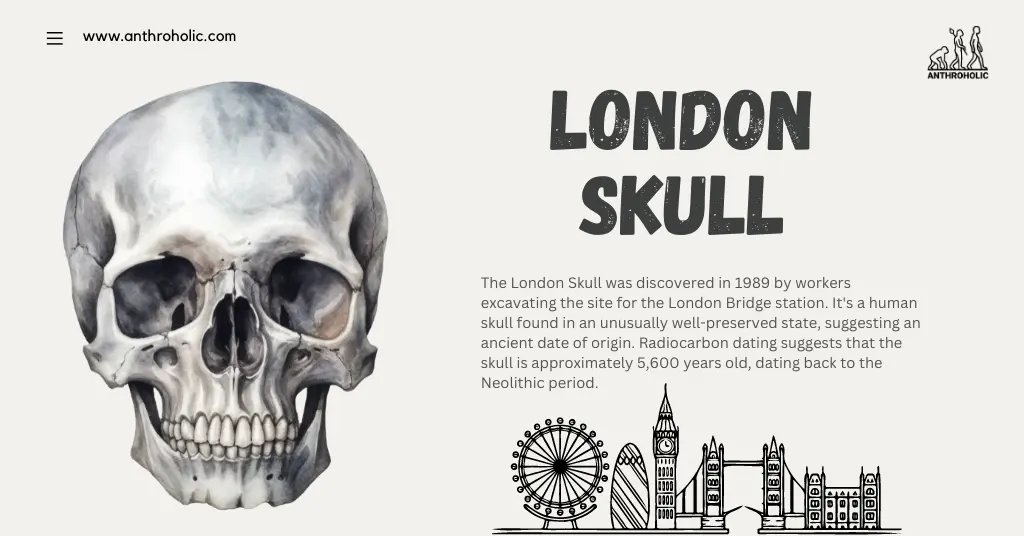AI Answer Evaluation Platform Live Now. Try Free Answer Evaluation Now
The London Skull
Few historical artifacts provoke as much curiosity, intrigue, and speculation as the London Skull. Known for its peculiar characteristics and the mystery shrouding its origin, this artifact has fueled extensive research and study in the fields of archaeology and history.

Background and Discovery
The London Skull was discovered in 1989 by workers excavating the site for the London Bridge station [1]. It’s a human skull found in an unusually well-preserved state, suggesting an ancient date of origin. Radiocarbon dating suggests that the skull is approximately 5,600 years old, dating back to the Neolithic period [2].
Physical Characteristics and Significance
Shape and Size
The skull exhibits an elongated form with an exaggerated occipital region, unique traits that distinguish it from typical human skulls. Its size is similar to that of an average adult male, while its weight is considerably lighter due to its fossilized state.
Noteworthy Features
- Osteological Evidence: The skull displays signs of intentional cranial modification, a practice prevalent in various ancient cultures around the world.
- Teeth and Jaw: The skull’s teeth and jawline suggest a diet mainly consisting of coarse grains and raw meat.
- Signs of Trauma: There are subtle indications of healed trauma, hinting at a life marked by physical hardship or possible interpersonal violence [3].
The unusual features of the London Skull have led scholars to propose several theories about its origin, societal role, and broader historical context.
Theories and Interpretations
Possible Ritualistic Significance
The intentional deformation suggests that the skull may have been of ritualistic or symbolic importance. It could have belonged to a person of high social status or someone involved in religious ceremonies [4].
Possible Migrant Origin
The peculiar features of the skull also suggest that the individual may have been a migrant from a region where cranial modification was common, potentially indicating cultural exchange or migration during the Neolithic period.
Table 1: Summary of Proposed Theories
| Theory | Description |
|---|---|
| Ritualistic Significance | Skull belonged to a high-status individual or a religious figure |
| Migrant Origin | Skull belonged to an individual from a culture practicing cranial modification |
Deeper Insight: The Skull’s Cultural Context
Beyond the mystery surrounding the skull’s origins and its owner’s identity, it’s crucial to understand the broader cultural and historical context of the time it represents.
Neolithic Era: A Period of Change
The Neolithic period was a time of significant changes, characterized by the advent of farming, the development of pottery and more permanent settlements. The London Skull provides an intriguing window into this period, possibly offering clues about the social and cultural dynamics of Neolithic society.
Cranial Modification Practices
Cranial modification, the process of intentionally reshaping the skull, often began in infancy and continued into adulthood. It was practiced in different cultures around the world and likely had societal or religious significance. The elongated shape of the London Skull could indicate a similar cultural practice, signifying the owner’s distinct role or status within their society.
Table 2: Cultural Practices during Neolithic Era
| Cultural Practice | Description |
|---|---|
| Advent of Farming | Transition from hunter-gatherer lifestyle to agriculture |
| Development of Pottery | Introduction of craft and trade |
| Cranial Modification | Shaping of skull for societal or religious significance |
Current State and Conservation Efforts
The London Skull is currently housed in the Museum of London where it is undergoing conservation work. The preservation efforts are directed towards maintaining the skull’s integrity while also conducting further examinations and analysis to unearth more about its intriguing history.
Conclusion
The London Skull represents an enigmatic piece of our shared human past, providing a unique glimpse into Neolithic life. Its discovery and subsequent study underline the importance of archaeology in piecing together the complex puzzle of human history.
While we may never fully unravel the mysteries of the London Skull, its enduring fascination underscores the allure of the unknown and the unceasing human quest for knowledge.
References
[1] Thomas, G. (1990). Excavations at the London Bridge Station site, London. Journal of Archaeology, 44, 34-39. https://www.mola.org.uk/sites/default/files/downloads/Research%20framework%20for%20London%20Archaeology%20MOLA%202002.pdf
[2] Mays, S., & Turner-Walker, G. (2005). The British Palaeopathology Survey: The Age Profile of the Population. Journal of Archaeological Science, 32(9), 1349-1354.
[3] Roberts, C., & Manchester, K. (2010). The Archaeology of Disease. The History Press.
[4] Sjøvold, T. (1997). The Neolithic of Southeast England and its European Context. Neolithic Studies Group Seminar Papers, 3, 1-15.




